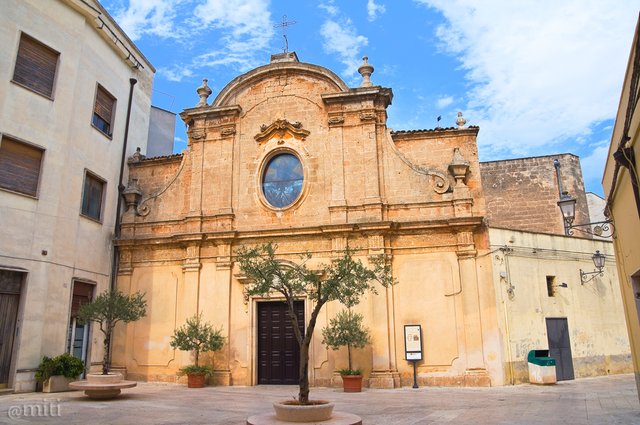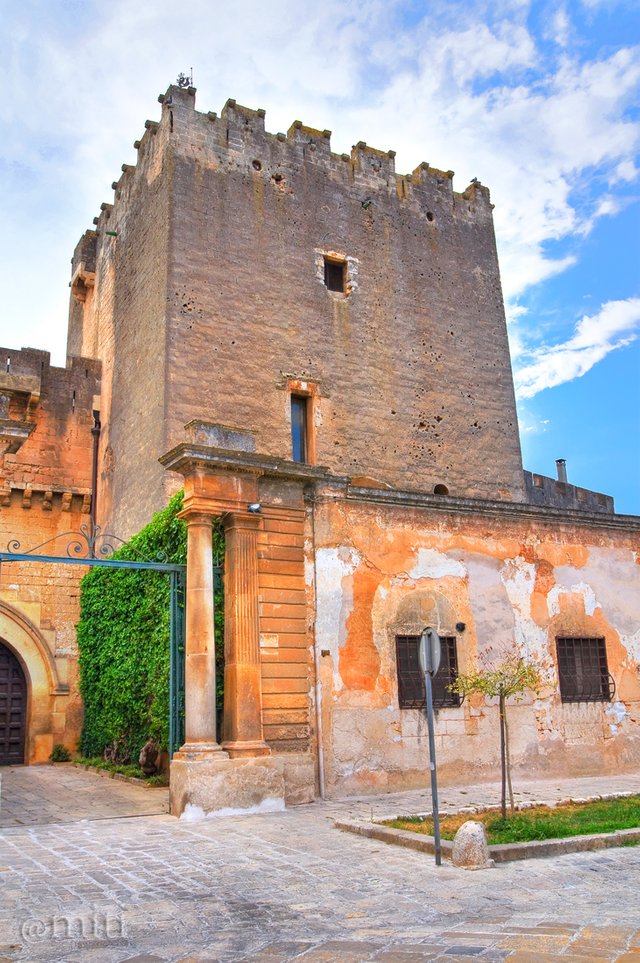A Journey through Italy: one photo every day #110 - SAN VITO DEI NORMANNI [ENG/ITA]

The Church of Santa Maria degli Angeli (Author's photo - All rights reserved)
Chiesa di Santa Maria degli Angeli (Immagine dell'autore - tutti i diritti sono riservati)



Ciao a tutti,
questo è un viaggio attraverso l'Italia. Posterò una foto al giorno con una brevissima descrizione. Spero vi piaccia!

San Vito dei Normanni è un piccolo borgo in provincia di Brindisi, nella regione italiana meridionale della Puglia. Si trova nel nord del Salento, con un centro storico ben conservato di epoca medievale.
L'area intorno alla città di San Vito fu abitata durante l'età del bronzo, ma l'insediamento moderno fu fondato nel X secolo come colonia per gli slavi in fuga dalla persecuzione dei Saraceni, sotto il nome di "Castro Sancti Viti". Molti ritengono che la città sia stata fondata dai Normanni Boemondo di Hauteville, figlio di Roberto Guiscardo, che portò al passaggio al suo attuale nome di San Vito dei Normanni negli anni '60 dell'Ottocento.
Camminando per le vie del centro storico il visitatore noterà sicuramente come quasi tutte le porte siano ricoperte da una "rezza" (dal latino Retia, ovvero rete) realizzata con piccole mattonelle orizzontali in legno di diversi colori, utilizzate per proteggere l'ingresso dal sole ma anche per la privacy. E' la città natale del musicista barocco Leonardo Leo (1694 - 1744), fondatore della scuola di musica napoletana, e sede di un importante centro mandolinistico, dove le tecniche di suono tradizionali sono ancora insegnate e praticate.
Il castello situato nel cuore del centro storico fu costruito da Boemondo di Altavilla nel XII secolo e ricostruito tra il XV e il XVI secolo. Appartiene ancora agli eredi della famiglia Dentice di Frasso. Il castello era in quei primi tempi usato forse come residenza di caccia per la corte, poiché l'intero territorio circostante era coperto da una fitta foresta.
Oggi la città, con le sue basse terrazze e le strade rettilinee disposte all'interno di una struttura a "scacchiera", conserva le imponenti torri feudali e la Chiesa barocca di Santa Maria della Vittoria. La Chiesa costruita alla fine del XVI secolo per commemorare la battaglia di Lepanto, ha tre navate e conserva all'interno l'icona Nicopeia, raffigurante la Vergine Maria che annunciava a Papa Pio V la vittoria di Lepanto sui Turchi e una preziosa statua in argento di San vito.
L'area intorno a San Vito è ricca di chiese rupestri e resti archeologici come il Paretone dei Greci, un muro megalitico di oscure origini che si estende per circa 2 km, e la chiesa rupestre di San Biagio, un santuario bizantino in mezzo a un intero villaggio scavato nel roccia, le cui pareti sono ricoperte da affreschi riccamente decorati.
Merita una visita il sito archeologico di Castello d'Alceste, con tracce di insediamenti dell'età del bronzo e successive fortificazioni messapiche.
Cosa vedere: Il Centro Storico, la di Santa Maria della Vittoria, la Chiesa di Santa Maria degli Angeli, il Castello Dentice di Frasso, il sito archeologico di Castello d'Alceste, il Paretone dei Greci , la Chiesa rupestre di San Biagio, la Chiesa di San Giovanni Evangelista, la Chiesa di Santa Maria della Mercede, la Chiesa di Santa Maria delle Grazie, la Chiesa dell'Annunziata, la Chiesa di San Michele Arcangelo, la cripta di San Giovanni, il Museo dell'Olio.

Hello everyone,
I began a Photo Journey through Italy. I will post one photo every day with a little note of explanation. I hope you like it!

San Vito dei Normanni is a small town in the province of Brindisi, in the southern Italian region of Puglia. It is located in the northern Salento, with a well preserved historic centre of medieval period.
The area around the town of San Vito was inhabited during the Bronze Age, but the modern settlement was founded during the 10th Century, as a colony for Slavs escaping the persecution of the Saracens, under the name "Castro Sancti Viti". Many believe the town was established by the Norman Bohemond of Hauteville, son of Robert Guiscard, which led to the transition to its current name of San Vito dei Normanni in the 1860s.
Walking along the streets of the historical center the visitor will surely notice how almost all doors are covered with a "rezza" (from the latin retia, meaning nets) made of horizontal wooden tiles in different colors, used to protect the entrance from the sun but also for privacy. It is the hometown of baroque musician Leonardo Leo (1694 - 1744), the founder of the Neapolitan music school, and the seat of an important mandolin center, where the traditional playing techniques are still taught and practised.
The castle located in the heart of the old town was constructed by Boemondo di Altavilla in the XII century and rebuilt between the XV and XVI centuries. It still belonging to the heirs of the Dentice di Frasso family. The castle was in those early times used possibly as a hunting residence for the court, since the whole territory around was covered with a thick forest.
Today the town, with its low terraces and straight roads arranged within a “chessboard” structure, preserves the massive feudal towers and the baroque Church of Our Lady of the Victory. The Church built at the end of the XVI century to commemorate the battle of Lepanto, with three naves, preserving inside the Nicopeia Icon, representing the Virgin Mary announcing to Pope Pius V the Lepanto victory on the Turks, and a precious silver statue of San Vito.
The area around San Vito is full of rock churches and archaeological remains such as the Paretone dei Greci, a megalithic wall of obscure origin stretching for about 2 km, and the rock church of San Biagio, a byzantine sanctuary amid a whole village excavated in the rock, whose walls are covered with richly decorated frescoes.
Worth a visit the archeological site at Castello d'Alceste, with traces of settlements of the Bronze Age and later Messapian fortifications.
Thing to see: The Historic Centre, the Church of Our Lady of the Victory, the Church of Santa Maria degli Angeli, The Castle Dentice di Frasso, the archeological site at Castello d'Alceste, the Paretone dei Greci, the rock church of San Biagio, the Church of San Giovanni Evangelista, the Church of Santa Maria della Mercede, the Church of Santa Maria delle Grazie, the Church of the Annunciation, the Church of San Michele Arcangelo, the St. John’s Crypt, the Oil Museum.

| Tipo di foto / Category | Paesaggio / Landscape view |
| Esposizione / Settings | 1/200 sec, ISO 200, f/10 |
| Camera | Nikon D5000 |
| Lente / Lens | Tamron SP 17-50mm f/2.8 XR Di II LD |
| Filtro / Filter | Polarizzatore Hoya / Hoya Polarizing filter |
| Cavalletto / Tripod | Manfrotto MKC3-P01 |
| Località / Location | San Vito dei Normanni (Brindisi), Italia |
| Software | Photoshop / HDR |


The Castle Dentice di Frasso (Author's photo - All rights reserved)
Il Castello Dentice di Frasso (Immagine dell'autore - tutti i diritti sono riservati)
lovely as always
Congratulations, Your Post Has Been Added To The Steemit Worldmap!
Author link: http://steemitworldmap.com?author=miti
Post link: http://steemitworldmap.com?post=a-journey-through-italy-one-photo-every-day-110-san-vito-dei-normanni-eng-ita
Want to have your post on the map too?
Greetings friend miti, It must be interesting the Byzantine sanctuary, the photograph of The Castle Dentice di Frasso I like :)
This comment was made from https://ulogs.org
Hello my friend, it was an impressive sight when i saw the sanctuary!
Speriamo che l' architetto che ha costruito quell' edificio accanto alla Chiesa abbia sofferto molto, "fa schifo" sarebbe ancora un complimento per lui....e anche chi gli ha dato il permesso di costruirlo... HORROR!
Hai perfettamente ragione.. temo che la cosa sia anche peggio di così.
Ricordo di aver visto (sul posto) una cartolina che ritraeva la stessa Chiesa con accanto un palazzo storico. E' la ristrutturazione dello stesso (che sarà stata anche autorizzata) che ha prodotto quell'obbrobrio.
Molto spesso sono le amministrazioni a rovinare il nostro patrimonio storico-culturale.
Si purtroppo :-/ Ma si puó sempre ributtare giú e speriamo presto:-)))
I love historical places
great pictures, great post, do you travel a lot?
Yes... Guess you could say I'm kind of blessed.
Wow very wonderful art class. thank you friend . your post is very important and great full . thank you so much.
You're welcome.
Never been to Italy, but always thought about going, now I need to go, great photo's.
Thank you!
These buildings look very historical and concordances, and there must be many interesting stories behind them!
Yes. I'm sure it is.
Now I want to travel :)